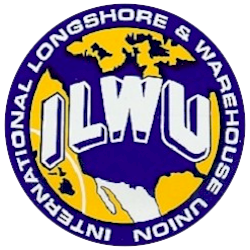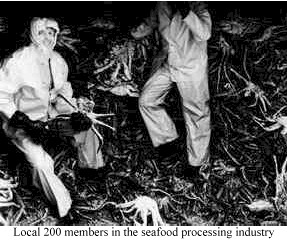
The ILWU Story

The ILWU Story
Alaska
The creation of the Marine Division has strengthened the presence of ILWU in Alaska through coordination and cooperation between the IBU shoreside and maritime members, the Region 37 cannery workers, and ILWU Local 200’s longshore, health care, cold storage and general industry members.
 ILWU organizing in Alaska has always been difficult: distances between cities
and work sites, an ever-changing workforce, shifting patterns of
seasonal employment, and raids by other unions have challenged ILWU
leaders and rank and filers since the first organizing efforts of the
1930s.
ILWU organizing in Alaska has always been difficult: distances between cities
and work sites, an ever-changing workforce, shifting patterns of
seasonal employment, and raids by other unions have challenged ILWU
leaders and rank and filers since the first organizing efforts of the
1930s.
As a result, ILWU organization has sometimes been erratic, and the ability to service outlying units has sometimes fallen short of expectations. Since the 1970s, however, a new generation of workers – responding to a transformation of the state’s economy – has grappled with these problems and has developed a new and more effective structure for the ILWU in Alaska.
The realignment of the ILWU in Alaska took place as the result of new growth after 1975, beginning with new organizing among seafood processing workers. Unity was given a boost in 1981, when all Alaska longshore locals were finally working under one agreement – covering both ILWU and IBU shoreside workers.
Then, 1983, members of the all
ILWU fish and longshore locals – which had since 1978 functioned as 16 small and separate members of the ILWU’s
Alaska Council – voted to consolidate their administration and
resources into one new unit: Local 200.
small and separate members of the ILWU’s
Alaska Council – voted to consolidate their administration and
resources into one new unit: Local 200.
In 1985, Local 200’s occupational jurisdiction in Alaska took on a new look when nursing, professional service, and administrative employees at Bartlett Memorial Hospital in Juneau signed up with the union.
The addition of the Bartlett unit helped invigorate the local, and in 1986 led to the first Alaska area convention called to discuss strategic planning and possible restructuring.
The convention decided to re-organize the Local into regional units with industrial divisions: longshore, health care, cold storage, and public service workers.
This new, coo rdinated approach
to ILWU organization in Alaska helped the units in the 1990s to meet a
serious threat to ILWU jurisdiction from a new direction: the giant
factory ships of foreign fishing fleets
rdinated approach
to ILWU organization in Alaska helped the units in the 1990s to meet a
serious threat to ILWU jurisdiction from a new direction: the giant
factory ships of foreign fishing fleets
A loophole in the 1990 Immigration Act was being interpreted by foreign shipowners as license to have seamen on foreign-flag vessels do longshore work aboard their ships when they were in U.S. ports.
This loophole frequently was being used by large Japanese fish trawlers operating in U.S. coastal waters— mainly Alaska – to bypass ILWU longshore labor in the transfer of their catch to shoreside facilities or other ships.
In 1995 after a two-year battle in Washington, D.C., with the Immigration and Naturalization Service and the Department of Labor, the ILWU won adoption of the "Alaska Exception," which closed the loophole.
ILWU longshore workers in Alaska are now assured of having first opportunity to work aboard the foreign fish trawlers.